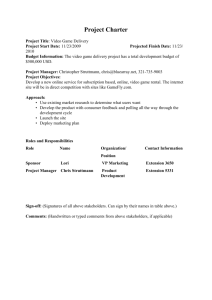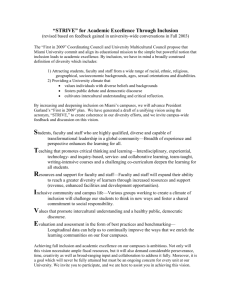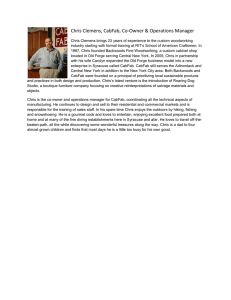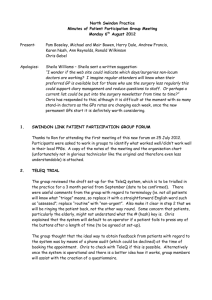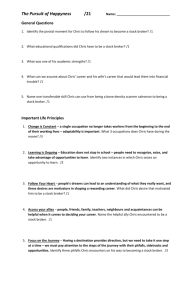Community Schools & Enterprise
advertisement
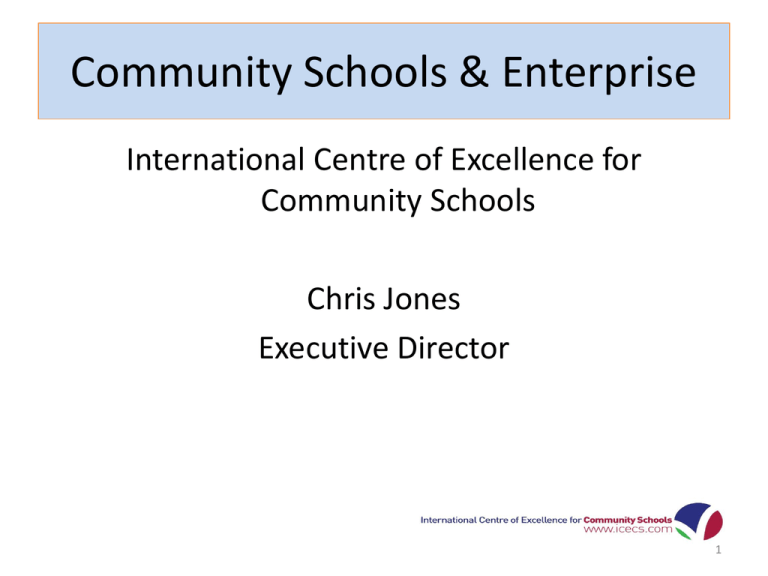
Community Schools & Enterprise International Centre of Excellence for Community Schools Chris Jones Executive Director 1 This workshop There will be three sections: • Brief presentations • Introduction to International Quality Standards for Community Schools • Activity about partnership • Presentations • Chris Jones, Executive Director of ICECS • Jane Quinn, Children’s Aid Society, USA 2 The Community Schools context Children starting school today will be retiring in 2075. What will the world look like then? New technology Migration - one in every 35 people is an international migrant. Economic restructuring and the global economy Environmental change 3 Our children in the future What does this mean for children in the future? – – – – – Competitive edge Transferable life skills Entrepreneurship Open to new cultures Health literacy 4 Community Schools: an institutional response 55 countries Local focus points e.g.,citizenship and democracy, raising standards and achievement, gaining community support for education Eastern Europe, central Asia and Russia network Coalition for Community Schools in USA National network in Canada Sub Saharan Network – Zambia, Namibia, Botswana, South Africa, Zimbabwe 5 UK schools: common practice and part of inspection Engagement of parents Leadership training and support Open to the wider community Partnerships Variety of teaching methods After school provision and access to childcare Policies and procedures for inclusion, safeguarding children 6 International Centre of Excellence for Community Schools • • • • Information and advice Training Resources Access to highly skilled people in many countries – leadership, partnership, social inclusion, school culture, lifelong learning, curriculum development 7 Community Schools in the US • Viewed as a strategy, not a program • A strategy for organizing school and community resources around student success • At least 90 cities and districts in the US are currently implementing this strategy as a school improvement approach • Unlike the UK, schools in the US are governed locally (not nationally) The “Developmental Triangle" Concept Community Family Child COMPREHENSIVE SUPPORT SERVICES Several well-known US models: Beacons (7 cities) Bridges to Success (United Way) Children’s Aid Society Community Schools Communities in Schools (national) Elev8 (Atlantic Philanthropies—4 cities) Healthy Start (California) Schools of the 21st Century (Yale U.) University-Assisted (U. of Pennsylvania) Underlying Research Base Making the Most of Non-School Time • Reginald Clark • Milbrey McLaughlin • Deborah Vandell Whole Child Approach/ Application of Developmental Knowledge • Jacquelynne Eccles • James Comer Parents’ Active Role • Epstein (six types) • Henderson and Mapp Coordinated Services Health-Learning Links • Charles Basch Consistent Adult Guidance & Support • Werner/Benard (resilience theory) • Fritz Ianni Newest Research New research from Chicago (Bryk et al.) found five essential ingredients: Principal: driver of change; inclusive leadership approach Real family and community engagement Ability to build professional capacity Student-centered school climate Coherent curriculum Key Ingredients Education is First (Overall Goal = Student Success) Lead Agency as Partner, Not Tenant Full-Time Presence of Lead Agency Joint Planning (Particularly between Principal and CS Coordinator) Integration of CS Staff into Governance and Decision-Making Bodies (e.g., School Leadership Team) Key Program Components After-School and Summer Enrichment Parent Involvement Adult Education Medical, Dental, Mental Health and Social Services Early Childhood Community and Economic Development CCS Research Report 2013 Recent report from Coalition for Community Schools summarizes latest research from across the United States Key results include improved academic performance, improved attendance, higher graduation rates, improved behavior, positive youth development, greater parental involvement Complete agreement on Standards we regard as common to all good practice • • • • • • • • • Leadership Partnership Social inclusion Services Volunteering Lifelong learning Community development Parent engagement School culture Piloted in 18 schools now being used in thousands 16 Self assessment school development school Not an inspection tool Can be used to gather evidence to show inspectors what the schools does Not a picture of what is, but a guide to what might be 17 Partnership We share decisions with partner agencies including community organizations • From the start we plan initiatives together with partners, parents and pupils • We include the experience of junior teachers, pupils, parents, community organizations when we design new initiatives • We share information with partners so that they can make informed decisions We take joint initiatives with partners • We share the responsibility and the risks for any initiatives we take • We share the rewards of successful initiatives • We promote and support the actions which are allocated to our partners We pool resources with partners for some initiatives to benefit the community and/or the curriculum • When feasible we put our resources into a joint fund to support a joint initiative • When feasible we offer the expertise of our staff for the implementation of joint initiatives • Where possible we include real life examples from business or the community in the contents of our teaching programs We have a written agreement setting out how we will work together • We know exactly how we will work with partners on each new initiative • Everyone is clear about who is taking the lead on which actions • We honour the agreement We promote and support each other’s activities • We include information about our partners in any publications, websites, reports etc as appropriate • We acknowledge the contribution made by partners in publicity, reports etc • We encourage community members to participate in the activities provided by partners We participate in local, regional and national networks of Community Schools • Whenever possible we attend networking events so that we can disseminate our work to a wider audience and to acquire new skills and knowledge • We inform other Community Schools about our work by sending them newsletters or other appropriate communications Our facilities are available for community use after school, at weekends and during school holidays • Our facilities are available to all groups and individuals regardless of their class, gender, age (as appropriate), sexual orientation, religion or ethnicity or their ability to pay • We make a special effort to ensure that individuals and groups who cannot afford to pay for the use of our facilities can access them We work with others to solve community issues • The school participates in solving problems that are affecting the community • The community is encouraged to participate in solving problems that are affecting the school • The school is willing to participate in activities initiated by other agencies where this will help solve problems in the community 18 Presenter Contact Information • Chris Jones, Executive Director, International Centre of Excellence for Community Schools, chris@cejassociates.co.uk • Jane Quinn, Director, National Center for Community Schools, The Children’s Aid Society, janeq@childrensaidsociety.org

